Abstract
In cellular communication systems, the introduction of device-to-device (D2D) communications provides a reasonable solution to facilitate high data rate services in short-range communication. However, it faces a challenging issue of interference management, where the cross-tier interference from D2D users to licensed cellular users (CUs) degrades their quality-of-service (QoS) requirements. D2D communications can also assist in offloading some nearby CUs to enhance the cellular operator’s benefit. To encourage the D2D transmitters (D2DT) to provide service to CUs in the dead zone, the cellular base station (CBS) needs to incentivize it with some monetary benefits. In this paper, a Stackelberg game-based joint pricing framework for interference management and data offloading is presented to illustrate the effects of cooperation between the D2D user and CBS. Specifically, a singular price is used to incentivize the D2DT to share its resources with the far-off CUs along with penalizing them for interference created at CBS. Simulation results illustrate the performance of the proposed technique in terms of the utilities of CUs and D2D users for varying distances of D2DT.
1. Introduction
The phenomenal amount of volume growth in Internet traffic is attributed to the proliferation of data-intensive applications that provide multimedia-rich services such as augmented reality, video over IP, online gaming, etc. According to CISCO, average Internet traffic is expected to grow 3.7-fold from 2017 to 2022 [1]. It is also estimated that mobile data traffic will increase by 77 exabytes per month by 2022, nearly a seven-fold rise above 2017 [2]. Furthermore, a huge number of intelligent devices are predicted to be connected to the Internet for the wide implementation of the Internet of Things (IoT). CISCO predicts that there will be around 1.5 billion IoT devices (with cellular connections) by 2020 [3]. Therefore, currently, as the most convenient data access method for mobile devices, the cellular networks are under immense pressure to meet the explosive data demand. The telecommunication industry and the research community need to investigate novel cellular architectures and paradigms to upgrade network capacity. In this scenario, device-to-device (D2D) communication presents one favorable solution to enhance spectral efficiency and augment capacity with minimal operational and capital expenditures. In D2D communication, the communication between two or more nearby mobile users takes place directly, i.e., without the intermediary of any infrastructure or base station (BS), which reduces communication delay, increases network throughput, and creates a cyber-physical space in a cellular environment [4,5,6,7]. In D2D, a D2D device can use one of the following mechanisms to operate. (i) Overlay mode: A D2D user is authorized to use the portion of the frequency spectrum that is not used by proximal cellular users (CU). This technique perhaps may not increase spectrum usage considering that D2D devices use a distinct resource with the CUs. (ii) Underlay mode: In underlay or reuse mode, D2D devices can use the same spectrum resource as the cellular users, on the condition of creating tolerable interference to their communication. This mode can substantially enhance system capacity. Moreover, the cellular operators can also make more profit through additional charges obtained from CUs for providing D2D service. In this paper, the focus is on the underlay spectrum sharing mode, where the D2D pairs reuse the spectrum of the CUs. One of the fundamental research challenges in reuse mode is the severe interference created in the cellular network by D2D communication due to the usage of shared spectrum resources. To ensure the quality-of-service (QoS) of cellular users, various interference mitigation techniques have been studied in the literature. In [8], the authors proposed a power control mechanism to control the peak transmission power of D2D transmitters (D2DT) by the base station. In [9], a more innovative technique was introduced, where resource allocation along with the power control technique was used to combat the interference from D2D to cellular users and vice versa. A spectrum splitting framework was developed in [10] to minimize interference in the D2D-cellular network. To assist in the uplink transmission of CUs to BS, relay nodes were selected in [11], and network coding was applied for the actual transmission. In [12], a multiple-input and multiple-output (MIMO) beamforming technique for the multiple-antenna D2D underlying cellular network based on estimated channel state information (CSI) was presented.
In addition to interference management using power control, our scheme essentially addresses the collaboration of D2D users with CBS to enhance the throughput of the CUs. The current BS-centric model, in which BS acts as an intermediary between users, may not be able to address the high demand mobile data traffic of the licensed CUs due to the limitation in infrastructural facilities. D2D users can take advantage of the physical closeness of the communicating devices and assist to reduce the traffic congestion of the cellular network. In this case, certain D2D users may convey content that is probably needed by neighboring CUs. Therefore, offloading of licensed cellular users to D2D users can provide a promising solution. Some notable research efforts on D2D-CBS cooperation in the literature are as follows. Mobile data offloading using D2D communications was presented in [13]. The authors formulated a Stackelberg game in [14], where CBS inspired D2D users to distribute their content to nearby CUs. Furthermore, in [15], the authors introduced an economic model where the users with similar demand cooperatively downloaded content from BS and exchanged the downloaded portions with each other directly. Social relationships between transmitting and cooperating users were integrated with the user’s consent in [16]. Meanwhile, a cooperative relaying-based spectrum sharing approach for the cellular and D2D communication was developed in [17] using a contract framework. To encourage femto access points (FAPs) to introduce a hybrid access mechanism, the authors in [18] studied a rate-based pricing framework to charge the transmission rates of the served mobile user equipment (MUE).
Both the power control and data offloading require penalty and incentive mechanisms respectively. Without imposing a penalty on D2D users, they may create interference to the cellular communication that may exceed an acceptable threshold. Similarly, D2D users may be reluctant to dispense the popular content within a limited area due to the additional amount of resources involved in the process. Therefore, they may need some incentives to cooperate with CBS in disseminating the information to far-off CUs. The incentive schemes used in the literature are primarily classified into three methods: the reputation-based mechanism, resource-based mechanism, and monetary-based mechanism. In the reputation-based mechanism, a centralized authority collects information regarding the activities of users. In this scheme, the cooperative users benefit, and non-cooperating users are punished [19,20]. These schemes depend on the performance of secure hardware to collect and assess reputation credits. In resource-based mechanisms, nodes can use their own resources to assist other nodes in exchange for getting resources from that node (e.g., act as a relay) [21]. However, if the primary users have a higher demand for spectrum, they may not consent to use the spectrum for resource exchange. In monetary-based schemes, virtual currency is used to benefit and hence promote the nodes to cooperate. Hence, the monetary-based mechanism becomes an appropriate mechanism, which has been widely used to solve cooperation-stimulation problems [22]. The most well-known monetary schemes for the scenarios where the operators will control and charge for D2D communications and incentivize the cooperating nodes are based on game models [23]. Hence, in this paper, a Stackelberg game is used to develop a pricing model for operator and D2D terminals. Specifically, in our scheme, a joint penalty-based power control and incentive-based cooperation scenario is considered. Previously, in [24], a discount proportional to the time-sharing services on interference price was introduced. However, in this work, a rate-based pricing scheme to incentivize the D2D users for providing offloading services to CUs is investigated. The main contributions of this paper are summarized as follows:
- (i)
- A joint penalty-based power control scheme and incentive-based data offloading are proposed for the D2D communication in a D2D-underlaid cellular network, where the CBS offers a rate-based incentive to the D2D user for offloading the CU.
- (ii)
- A singular pricing mechanism is used to penalize the D2D user for interference and to incentivize the D2D user to provide content to nearby CUs. A singular price enables CBS to decide a fair price by taking into consideration the offloading of its contents using D2D users.
The remainder of the paper is arranged as follows. Section 2 presents the system model and problem formulation of the D2D-underlain cellular system. Section 3 explains the proposed optimal power allocation and pricing. Section 4 provides the analysis of the proposed game followed by simulation results in Section 5 and the conclusion in Section 6.
2. System Model
The operation of a cellular system underlain with D2D communications is considered as shown in Figure 1. It is supposed that D2D users reuse the uplink spectrum of the cellular system. The reason to share the uplink band of CBS is that it is easier to manage the interference at CBS. In the D2D layer, D2D pairs coexist with CUs and are able to transmit multiple signals at the same time. At a specific time interval, a single CU uses a subchannel in the uplink spectrum; whereas a D2D pair uses the same subchannel for communication as in underlay mode.
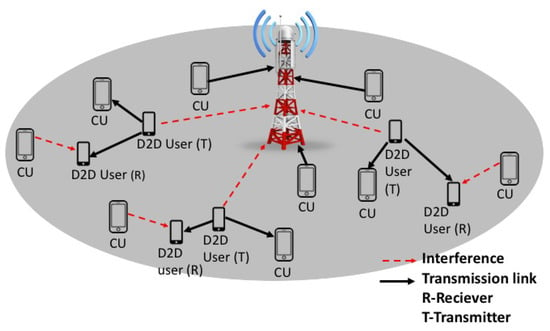
Figure 1.
System model comprised of a cellular base station (CBS) and D2D pairs. CU, cellular user.
However, when D2DT sends data to its receiver, it brings about harmful interference to the CBS (cross-tier interference). If is assumed as the path loss between the D2D pair and CBS, then the interference created at the CBS is , where is the transmit power of D2DT. The CBS guarantees that the total interference experienced by it is less than the tolerable interference threshold To ensure this, the CBS imposes a price on D2D users to create interference on its licensed channels. The interference threshold is generally implemented at the base station in heterogeneous networks [25] and at the primary user in cognitive radio networks [26]. Furthermore, there exists a set of CUs within the communication range of the D2DTs () that attaches to the close-by D2DT, when their requested content matches the D2DT content.
However, a D2DT may be reluctant to provide service to a nearby CU; therefore, it needs to be incentivized with some economic benefits from CBS. In this paper, a linear pricing function is used because of its implementation complexity.
The achievable signal-to-interference plus noise (SINR) of the D2D pair can be expressed as:
where denotes the transmit power of the D2DT. represents the link gain among the D2D pair. The parameter signifies the white Gaussian noise power with zero mean and a common variance , while represents the interference from CUs to the D2D receiver (D2DR).
Problem Formulation
Without cooperation between D2DT and CBS, the data rate at the CU can be given as:
where and represent the channel power gain and transmitted power between CBS and the CU. However, when successful cooperation occurs between CBS and D2DT, the D2DT sets aside a power fraction for its signal to D2DR, and the data rate at the CU will become:
signifies the channel power gain between the D2DT and offloaded CU. implies the transmit power of the D2DT. The CBS aims to motivate D2DT to provide resources to the CU and ensure their QoS obligation. Therefore, D2DT should maintain the minimum transmission rate of CU. Hence, cooperation can only take place if:
or equivalently, , where can be expressed as:
where represents the highest fraction of power that D2DT can allocate to its signal. Therefore, the far-off CUs require at least to meet the data rate constraint provided in Equation (4). The amount of resources allocated by D2DT to CU should also satisfy the following condition:
where represent the required data rate of the CU. Correspondingly,
The data rate achieved by the D2DR can then be expressed as:
Moreover, it is assumed that D2DR has a rate requirement of . To ensure the QoS of D2DR, the achievable power allocation should be more than the power demand of D2DR. Hence,
or:
where and denote the lower and upper limits of .
3. Proposed Incentive-Based Offloading and Penalty-Based Power Control Algorithm
3.1. Stackelberg Game for Power Allocation and Pricing
A Stackelberg game [27] is a type of non-cooperative game, where the intelligent entities choose their actions/strategies selfishly without consulting each other. Every entity is interested in its own pay-off and makes all decisions individually. Specifically, a Stackelberg game is comprised of a leader and followers (entities). The leader decides first, and the followers decide afterward. The optimal action is established by the leader, presuming that the followers react by optimizing their pay-off functions based on the leader’s strategy. The solution to the Stackelberg game model can be achieved by obtaining Stackelberg equilibrium (SE). SE corresponds to an equilibrium condition, where each entity is assumed to know the steady-state actions of the other entities, and no entity can receive more advantage by changing its action unilaterally.
In the proposed model, from the perspective of CBS, the primary concern is to maximize its profits by adaptively determining the price. From the perspective of D2D users, how to profitably allocate their resources is the main problem. Based on the repeated interplay of CBS and D2D users, the Stackelberg game can achieve a globally desirable system performance. In this game, the CBS operates as a leader that first anticipates the reaction (power allocation factor ) of D2D pairs and prices them corresponding to interference experienced by them. The proposed Stackelberg game is represented in Figure 2.

Figure 2.
Stackelberg game for the proposed price model. D2DT, D2D transmitter; D2DR, D2D receiver.
3.2. Utility Functions In the Proposed Stackelberg Game Model
To mitigate the interference to a CU on a common subchannel, the CBS charges the D2DT an interference cost. It is supposed that the interference price that the D2D pair needs to pay varies linearly in an amount to the power. Since the power allocated to the D2DT-D2DR signal is , therefore the total payment charged on D2D user communication is . For the D2D user, the price can be viewed as the penalty for exploiting the licensed channel. For CBS, the price can be considered as the payment for its probable service quality deterioration caused by the D2D user. The price also linearly relates to the power fraction resource for the offloaded CU. The value of ranges between [0,1]. If the D2DT cooperates with the CBS, then it will also earn a proportion of incentive related to the price announced by the CBS and the remaining power fraction. The utility of D2DT can be modeled as:
At the CU side, CBS intends to motivate D2DT to open resources to the CU and ensure their QoS requirements. Similarly, the utility of CBS for the CU can be expressed as:
If the cooperation is established between the CBS and D2DT, the utility of CBS will consist of the benefit achieved by the rate of CU and the interference penalty obtained from the D2DT. The cost represents the incentive price paid to the D2DT for providing service to CU.
Therefore, the optimization problem at the D2DT side can be expressed as:
s.t.
denotes the interference threshold sustained at CBS.
It can be noticed from P1 that D2DT can earn revenue by allocating power to CU, at the expense of lowering the transmission rate of its own D2DR.
The optimization problem at the CBS side can be expressed as:
s.t.
Problems in Equations (11) and (16) jointly form a Stackelberg game [10], which is solved to have both D2DT and CBS act sequentially to achieve the Stackelberg equilibrium (SE), i.e., the optimal price and fraction of power resources allocated to D2DT and offloaded CU by optimizing their respective utilities.
4. Game Analysis
4.1. Power Allocation Strategy of D2DT
Our goal is to search for that maximizes while holding the constraints in Equations (12)–(15) valid. If is given, D2DT determines the transmit power allotment factor , between its own user and the offloaded CU, as follows:
the optimal is derived by taking the first derivative of with respect to and setting it to zero. The value of must also fulfill the conditions in Equations (13) and (15), as well as:
provided that . Hence,
4.2. Incentive and Interference Strategy of CBS
CBS decides its interference and incentive pricing strategy by taking into account the predicted behavior of the D2D pair strategies. Equation (19) is substituted in Equation (16) to express the pay-off function of CBS as:
The first derivative of Equation (21) with respect to the price can be given as:
To get the maximum values, we let . Since Equation (24) consists of a quadratic form, therefore it is solved using the quadratic formula for the price .
where:
and:
The implementation algorithms for the Incentive and Penalty Mechanism for D2D-Cellular Communication is given in Algorithm 1.
| Algorithm 1 Incentive and Penalty Mechanism for D2D-Cellular Communication |
|
5. Simulation Results
In this section, the performance of the the proposed Stackelberg game model is demonstrated with MATLAB. The parameter settings for the simulations are summarized in Table 1. For explanation purposes, we considered a D2D-underlain cell with one CBS located in the center and K = 35 D2D pairs located within the coverage of the cell. Here, it was considered that one CU was offloaded to one D2DT. The fading channels were modeled as , where a signifies the small-scale fading factor using the Rayleigh fading process and L implies the distance between the transmitter and receiver. represents the path loss exponent specified as three for the large-scale fading.

Table 1.
The simulation parameters.
Figure 3a illustrates the effect of the optimal power allocation factor for varying distances between CBS and D2DT. In this figure, it is observed that as the distance between D2DT and CBS decreases (correspondingly, the SINR decreases and the interference created at CBS increases), the decreases, which means that the D2DT can now use less power to transmit to D2DR. The value of for varying interference thresholds is plotted, and it is observed that as the interference threshold becomes stricter, less interference is tolerated at CBS; hence, the cooperation does not occur at shorter distances (low SINR). At longer distances between CBS and D2DT (high SINR), the should increase, as now, D2DT can afford to transmit at higher power, but since the utility function also consists of offloading power factor for a CBS user, the increases almost negligibly.
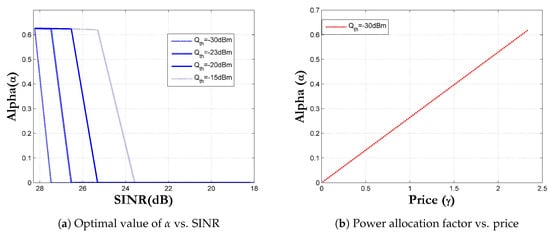
Figure 3.
Optimal value of power allocation factor and its relationship with price .
Figure 3b shows the relationship between the power allocation factor and the price . Since CBS charges D2DT for the price of creating interference at it, the relationship observed is linear. When increases, the price increases because now, D2DT allocates more power to its D2DR, which will naturally increase the interference at the CBS side; hence, the price increases.
Figure 4a,b depicts the impact of interference created at CBS on CBS and D2DT utility. The utilities of CBS and D2DT are plotted against the increasing distances between CBS and D2DT. We notice that when the interference threshold is not met, the utility of D2DT is zero, i.e., the cooperation does not occur. This is because in order to meet the requirements of (set by CBS), the D2DT will try to reduce the , and the required constraints are not met. A similar scenario happens in the case of CBS utility when the cooperation does not exist: the utility becomes zero. The correspondence between the utility at different thresholds is attributed to the value of at varying CBS-D2DT distances.
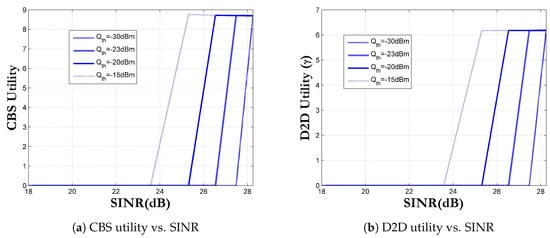
Figure 4.
Utilities achieved using the proposed scheme.
Figure 5 shows the impact of cooperation on CBS utility with varying . With the cooperation between CBS and D2DT, CBS utility increases. The plots for CBS utility in the case of cooperation are plotted for the case when there is no cooperation, i.e., when the is zero, in which case the utility is zero as no power is allocated to CBS either, and then, for the case when the cooperation happens at in which case the throughput of CBS increases, which is consistent with our analysis in Section 3.
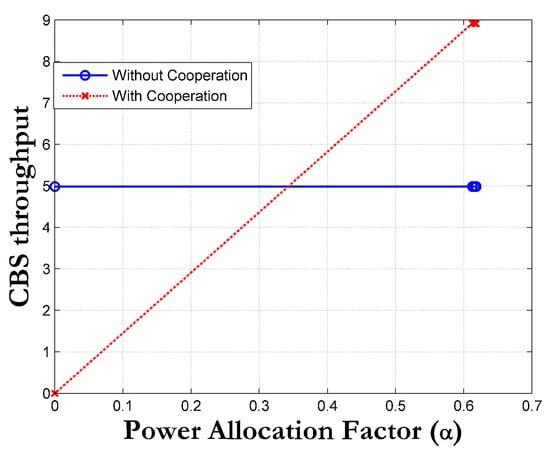
Figure 5.
CBS throughput with and without cooperation.
Figure 6 plots a very interesting relationship between interference created at CBS and the price . As the distance starts to increase (SINR increases), D2DT tries to dedicate more power to its D2DR (by increasing ), but in this process, the CBS charges it more price, to control it from allocating too much power to its own user. Figure 7 depicts the influence of price on the total received interference. One can observe that the aggregate interference starts high, but it decreases as more price is charged.
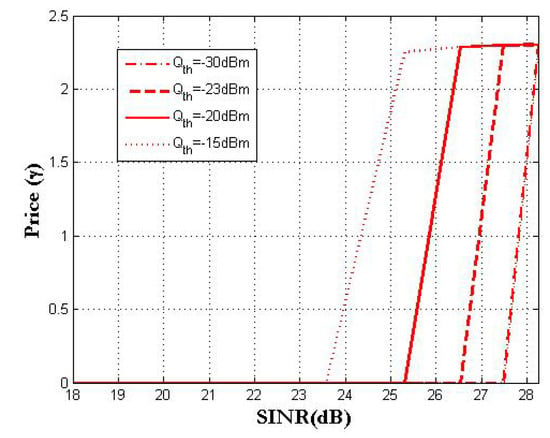
Figure 6.
Price variation vs. SINR.
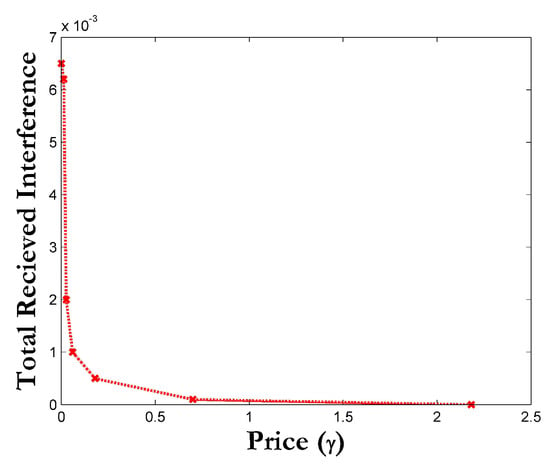
Figure 7.
Total interference at CBS.
6. Conclusions
In this paper, an incentive mechanism was proposed to motivate a D2D user to offload CU along with a penalty-based power control mechanism to manage the interference created at CBS. A single price scheme was used for both incentivizing and penalizing the D2D user. The cooperation between the CBS and D2D user was modeled using a Stackelberg game. In this game, the CBS acted as a leader purchasing the power resources needed by its CU from the D2D user, while the D2D user was considered as a follower, deciding its optimal fraction of power resources for both its own user and offloaded CU based on the released price (made known by CBS) subject to the QoS constraints of the D2D user. Stackelberg equilibrium for this game was derived using the backward induction method. The results presented demonstrated that the cooperation between CBS and the D2D user would provide acceptable performance in terms of achieved utilities. A D2D user could share power-based resources with far-off CU, ensuring their QoS-based requirements were met with cross-layer interference managed under a pre-defined threshold. The proposed power-sharing-based D2D-cellular cooperation scheme enabled CUs to obtain QoS-based throughput at the cost of a tolerable decrease in the achievable data rate of the D2D user (receiver).
Future work: Future works will consider the rate-based sharing in mobile data offloading with the energy harvesting model. An energy interaction between CBS and the D2D user will be formulated using game theory. The D2D users will act as market leaders determining the amount of energy they need to buy and the amount of resources they will share with CBS. CBS will then decide the discounted energy price.
Author Contributions
Conceptualization S.N.; methodology, S.N.; software, S.N.; validation, S.N. and N.S.; writing, original draft preparation, S.N. and N.S.; writing, review and editing, S.N., N.S., A.R.; supervision, N.S and A.R. All authors have read and agreed to the published version of the manuscript.
Funding
This research received no external funding.
Acknowledgments
The authors would like to thank the anonymous reviewers and the Editor for their careful reviews and constructive suggestions to help us improve the quality of this paper.
Conflicts of Interest
The authors declare no conflict of interest.
References
- Available online: https://www.cisco.com/c/en/us/solutions/collateral/service-provider/visual-networking-index-vni/\white-paper-c11-741490.html (accessed on 20 July 2019).
- Available online: https://www.cisco.com/c/en/us/solutions/collateral/service-provider/visual-networking-index-vni/\white-paper-c11-738429.html (accessed on 20 July 2019).
- Available online: https://www.ericsson.com/en/mobility-report/internet-of-things-forecast (accessed on 20 July 2019).
- Villalonga, A.; Beruvides, G.; Castaño, F.; Haber, R. Industrial cyber-physical system for condition-based monitoring in manufacturing processes. In Proceedings of the 2018 IEEE Industrial Cyber-Physical Systems, ICPS 2018, Saint Petersburg, Russia, 15–18 May 2018; pp. 637–642. [Google Scholar]
- Castaño, F.; Strzelczak, S.; Villalonga, A.; Haber, R.E.; Kossakowska, J. Sensor reliability in cyber-physical systems using internet-of-things data: A review and case study. Remote Sens. 2019, 19, 2252. [Google Scholar] [CrossRef]
- Saxena, N.; Roy, A.; Kim, H. Traffic-Aware Cloud RAN: A Key for Green 5G Networks. IEEE J. Sel. Areas Commun. 2016, 34, 1010–1021. [Google Scholar] [CrossRef]
- Saxena, N.; Roy, A.; Sahu, B.; Kim, H. Efficient IoT Gateway over 5G Wireless: A New Design with Prototype and Implementation Results. IEEE Commun. Mag. 2017, 55, 97–105. [Google Scholar] [CrossRef]
- Doppler, K.; Rinne, M.; Wijting, C.; Ribeiro, C.; Hugl, K. Device-to-Device communication as an underlay to LTE-advanced networks. IEEE Commun. Mag. 2009, 47, 12, 42–49. [Google Scholar] [CrossRef]
- Gu, J.; Bae, S.; Choi, B.; Chung, M. Dynamic power control mechanism for interference coordination of device-to-device communication in cellular networks. In Proceedings of the 2011 Third International Conference on Ubiquitous and Future Networks (ICUFN), Dalian, China, 15–17 June 2011; pp. 71–75. [Google Scholar]
- Mustafa, H.; Shakir, M.; Sambo, Y.; Qaraqe, K.; Imran, M.; Serpedin, E. Spectral efficiency improvements in HetNets by exploiting device-to-device communications. In Proceedings of the 2014 Globecom Workshops (GC Wkshps), Austin, TX, USA, 8–12 December 2014; pp. 857–862. [Google Scholar]
- Wang, L.; Tian, F.; Svensson, T.; Feng, D.; Song, M.; Li, S. Exploiting full duplex for device-to-device communications in heterogeneous networks. IEEE Commun. Mag. 2015, 53, 146–152. [Google Scholar] [CrossRef]
- Fu, W.; Yao, R.; Gao, F.; Li, J.; Lei, M. Robust null-space based interference avoiding scheme for D2D communication underlaying cellular networks. In Proceedings of the 2013 Wireless Communication Networking Conference (WCNC), Shanghai, China, 7–10 April 2013; pp. 4158–4162. [Google Scholar]
- Rebecchi, F.; De Amorim, M.D.; Conan, V.; Passarella, A.; Bruno, R.; Conti, M. Data offloading techniques in cellular networks: A survey. IEEE Commun. Surv. Tuts 2015, 17, 580–603. [Google Scholar] [CrossRef]
- Shang, B.; Zhao, L.; Chen, K.C. Operators Economy of Device-to- Device Offloading in Underlaying Cellular Networks. IEEE Commun. Lett. 2017, 21, 865–868. [Google Scholar] [CrossRef]
- Fang, L.; Zhang, R.; Cheng, X.; Xiao, J.; Yang, L. Cooperative Content Download-and-Share: Motivating D2D in Cellular Networks. IEEE Commun. Lett. 2017, 21, 1831–1834. [Google Scholar] [CrossRef]
- Yang, P.; Zhang, Z.; Yang, J.; Wang, X. Incorporating User Willingness in Contract-Based Incentive Mechanism for D2D Cooperative Data Forwarding. IEEE Access. 2018, 6, 54927–54937. [Google Scholar] [CrossRef]
- Ma, C.; Li, Y.; Yu, H.; Gan, X.; Wang, X.; Ren, Y.; Xu, J.J. Cooperative Spectrum Sharing in D2D-Enabled Cellular Networks. IEEE Trans. Commun. 2016, 64, 4394–4408. [Google Scholar] [CrossRef]
- Li, L.; Wei, M.; Xu, C.; Zhou, Z. Rate-Based Pricing Framework in Hybrid Access Femtocell Networks. IEEE Commun. Lett. 2015, 19, 1560–1563. [Google Scholar] [CrossRef]
- Chen, Y.; Kishore, S. A game-theoretic analysis of decode-and forward user cooperation. IEEE Trans. Wirel. Commun. 2008, 7, 1941–1951. [Google Scholar] [CrossRef]
- Wei, L.; Cao, Z.; Zhu, H. MobiGame: A user-centric reputation based incentive protocol for delay/disruption tolerant networks. In Proceedings of the 2011 Global Telecommunication Conference, Houston, TX, USA, 5–9 December 2011; pp. 1–5. [Google Scholar]
- Zhang, G.; Yang, K.; Liu, P.; Ding, E.; Zhong, Y. Joint channel bandwidth and power allocation game for selfish cooperative relaying networks. IEEE Trans. Veh. Technol. 2012, 61, 4142–4156. [Google Scholar] [CrossRef]
- Wang, B.; Han, Z.; Liu, K.J.R. Distributed relay selection and power control for multiuser cooperative communication networks using Stackelberg game. IEEE Trans. Mob. Comput. 2009, 8, 975–990. [Google Scholar] [CrossRef]
- Yang, D.; Fang, X.; Xue, G. Game theory in cooperative communications. IEEE Wirel. Commun. 2012, 19, 44–49. [Google Scholar] [CrossRef]
- Noreen, S.; Saxena, N.; Roy, A. Discount Interference Pricing Mechanism for Data Offloading in D2D Communications. IEEE Commun. Lett. 2018, 22, 1688–1691. [Google Scholar] [CrossRef]
- Liu, F.; Song, X.; Wang, J. Price-based power control in heterogeneous: A Stackelberg game approach. In Proceedings of the 2016 2nd IEEE International Conference on Computer and Communications (ICCC), Chengdu, China, 14–17 October 2016; pp. 2869–2872. [Google Scholar]
- Wang, Z.; Jiang, L.; He, C. A Novel Price-Based Power Control Algorithm in Cognitive Radio Networks. IEEE Commun. Lett. 2013, 17, 43–46. [Google Scholar] [CrossRef]
- Han, Z.; Niyato, D.; Saad, W.; Baar, T.; Hjrungnes, A. Game Theory in Wireless and Communication Networks: Theory, Models, and Applications, 1st ed.; Cambridge University Press: New York, NY, USA, 2011. [Google Scholar]
© 2020 by the authors. Licensee MDPI, Basel, Switzerland. This article is an open access article distributed under the terms and conditions of the Creative Commons Attribution (CC BY) license (http://creativecommons.org/licenses/by/4.0/).